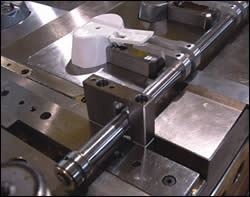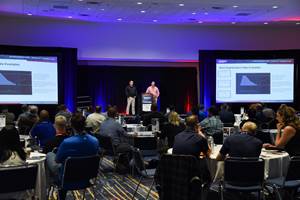Value-Added Mechanism Can Keep Moldmakers Competitive
Profine Molds™ (Oakville, ON)—a supplier of precision multi-cavity molds and hot runner systems—has developed its next generation, flip-top closing mechanism named proCLOSE™.
|
Profine Molds™ (Oakville, ON)—a supplier of precision multi-cavity molds and hot runner systems—has developed its next generation, flip-top closing mechanism named proCLOSE™ as part of the proSERIES™ of seven patented or patent-pending products first introduced to the market in August, 2005. This product was designed by the company as a way to continually add to its value-added products and services it offers to molders and OEMs—and therefore remain more competitive and profitable. The proCLOSE technology can be used for in mold closing on any type of flip top cap application—reducing post-molding labor costs and operations by eliminating the need for manual labor to close the lid. Other proSERIES products include the proRUNNER™ series of front-mounted, hot runner nozzles; proCORE™ technology for collapsing core applications and proSPEED™ injection molds for high-volume, multi-cavity applications. These products have quickly been accepted by Profine’s customer base as an alternative to traditional designs and systems. Developed at the company’s R&D center, proCLOSE™ offers improved technology featuring an actuator with a simplified mechanism, robust hydraulic, pneumatic or electric motors and a compact overall design. The technology reduces overall processing time to delivery of a finished part by taking advantage of more powerful servo motors with improved reliability. The mechanism can close up to 24 parts per cycle with the ability to adjust closing force onto the part. This is important to ensure part quality and cosmetics—cycle after cycle. The servo motors actuate a single low profile rod per mold side with attached lifters that gently lift and close the lid shut. The rack and pinion assembly also has been fined-tuned using improved manufacturing and refinement to design—providing smoother overall operation. According to Profine Molds president Manuel Gomes, “Our commitment to ongoing research and development—coupled with our partnering approach by working hand-in-hand with our customers—has lead to this next-generation technology. My approach has always been to look at the molders’ processes and their challenges, identify areas for improvements and to keep the solution simple. For example, when we developed proRUNNER, my approach was purely from the molders’ side. I identified the need for ease of use, reduced downtime and reduced dependency on the hot runner supplier. With each new or improved technology we introduce, we are committed to these continuous improvements with a focus on simplifying the process to keep our customers competitive in any market.” Wayne Stoddard, marketing manager for Profine Molds, adds that “the enhanced technology of proSERIES products like proCLOSE and proRUNNER showcases Profine Molds’ simple but effective approach on how moldmakers can improve process—and ultimately profits—for molders. Lower part costs made possible by taking advantage of technology investments is one way for processors to reduce overall costs—particularly in established industrial countries where labor costs are a large part of the operational budget. Going beyond what a traditional mold shop offers, we will continue to aggressively push the technology button by leveraging our internal R&D capabilities. We deliver value-added solutions that optimize the entire process from part to production—providing strategic business-wise options to molders. It’s all about competitiveness and sustainable margins for both parties long-term.” proCLOSE technology is currently being sold with a Profine mold to molders only, not as a stand-alone item. Stoddard notes the initial response has been extremely positive—especially since resin prices have increased. “The additional cost to incorporate proCLOSE is not inexpensive, but with companies looking very closely at their process and moving to a stronger business approach, we are able to justify with a cost analysis of what the ROI will be,” Stoddard explains. “We can look at the cost of manual labor to close the lids post-molding over the projected life of the tool versus the investment of adding proCLOSE to the mold. We can prove the business case.” |
Related Content
FAQs: What Are the Leadtime Leader Awards?
Here are answers to some frequently asked questions about MoldMaking Technology's annual Leadtime Leader Awards competition.
Read MoreDynamic Tool Corp: Leadtime Leader Insights and Bold Plans for the Future | MMT Chats
MoldMaking Technology Editorial Director Christina Fuges gets the scoop from our 2024 Leadtime Leader Award Winner Dynamic Tool Corp., on the company's future, their trade show experience, finding new talent and the impact of this industry recognition.
Read MoreThink Safety: Eliminate Hazards Throughout the Shop
The tooling community is taking advantage of new products for safer mold shops and molding facilities.
Read MoreMoldMaking Conference Session Spotlight: Data
Want to learn about digital workflows in mold design or ERP or global mold monitoring and asset management or the impact of tooling digitalization?
Read MoreRead Next
Reasons to Use Fiber Lasers for Mold Cleaning
Fiber lasers offer a simplicity, speed, control and portability, minimizing mold cleaning risks.
Read MoreHow to Use Strategic Planning Tools, Data to Manage the Human Side of Business
Q&A with Marion Wells, MMT EAB member and founder of Human Asset Management.
Read More

















